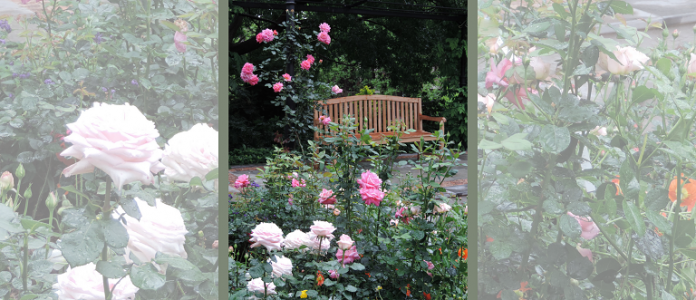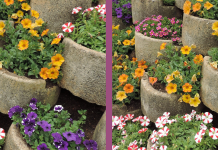Roses grow faster in September than at any other time and buds are forming for the October flush.
Giving the right kind of care this month will help the roses to be more resilient in the face of heat, pests and even possible drought for the rest of summer, says Ludwig Taschner of Ludwig’s Roses.
Watering
Deep watering at least once a week (for 40 minutes), rather than a daily dribble, ensures that water gets to the roots of the roses, where they need it most. Water availability at root level, especially now, determines the stem length, leaf and flower size.
As temperatures rise, water twice a week. Mulch the surface of the soil to keep it cool and moist. Use organic material like peanut shells, pine needles, or bark chips and put down a two centimetre layer. Don’t push the mulch up against the stems but leave a gap (see picture) for water and fertiliser to penetrate.

If the soil is compact or was not improved after pruning, dig in organics (including compost) to a depth of 30cm. This allows water to easily reach the roots. Drench after digging.
Protect new blooms and leaves
There is nothing more discouraging than blooms that are deformed when they open. Thrips is the main spoiler and it affects almost every rose garden. This tiny pest sucks the sap out of new shoots, leaving them crinkly and deformed (see picture) as well as sucking on the petals and drying the edges.

A long-term solution is to drench with Koinor, which is effective for up to six months. Otherwise start the spraying with a cocktail of Ludwig’s Insect Spray, Chronos, and Picanta, or use Rose Protector every two weeks.
Fertilise regularly
By mid-September the roses will need fertilising. Just as the growing bush draws up water, so it needs an abundant supply of nutrients to develop new leaves and flowering shoots. Well-fed roses are healthier, less susceptible to fungus disease and withstand insect infestations better.
From September to April, fertilise the roses once a month with Vigorosa which contains a balance of most, if not all, the required nutrients including the major N (nitrogen)-P (phosphorus) -K (potassium), as well as Epsom salts, Lime, Boron, other micro-nutrients and humic acid.
.
Finger prune hybrid tea roses
Hybrid tea roses are the picking roses because of their perfect blooms. Finger pruning spreads out the flowering so that in October the bush doesn’t produce all its blooms at once. Once the pattern has been set it continues throughout the summer.
Most importantly, staggering the flowering avoids root stress because fewer flowers are picked at once and there is a good balance of leaves remaining on the bush.

An added advantage of finger pruning is that it encourages the sprouting of the all-important water or basal shoots (see picture). These rejuvenate the bush and determine its height for the season. It is vital to finger prune basal shoots when they are just over knee height.
How to finger prune
Using your fingers, snap off a third of all new shoots, just before the shoots form a flower bud. If shoots are growing too close together, pinch out one of them. Also pinch out weak stems or those that are growing to the inside of the bush. Any number of shoots can be pinched; between three and six will achieve the expected result.
You can do a soft pinch or a hard pinch. A soft pinch removes just the tip of the still undeveloped, folded-up leaves at the top of the stem. Expect one new stem from each a soft pinch.

A hard pinch (see picture) snaps off the upper three or four leaves. Expect two or three new stems from a hard pinch.
Within a week new growth starts from the top of the pinched shoots and will be growing when the un-pinched stems are flowering.
Help for unhappy roses.
Roses that are not growing well and have started making flower buds on unnaturally short stems will benefit from finger pruning too.
Pinch off every shoot or remove every bud, because the formation of flowers uses up lot of energy. This builds up more leaves with a stronger downward sap flow. This strengthens the roots allowing them to penetrate further resulting in the pushing out of basal shoots and stronger re-sprouting at the top. The difference can be seen within three weeks.
Spring rose care talks:
Ludwig Taschner will be giving spring rose care talks in Johannesburg and Pretoria at the beginning of September and will include a finger pruning demonstration.
- Saturday 2 September: Ludwig’s Roses Egoli, 97 Lachlan road, Johannesburg at 10.30 am.
- Sunday 3 September: Ludwig’s Rose Farm at 10.30 am and at Pretoria East at 2 pm.
- Saturday 16 September: Ludwig’s Roses Big Red Barn (M18 Glen road, between Irene and Clayville) at 10am.
Attendance is free, no need to book.
For more information visit www.ludwigsroses.co.za
TEXT: Alice Coetzee.






